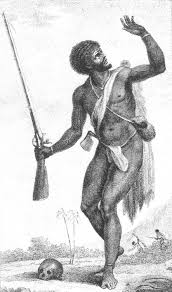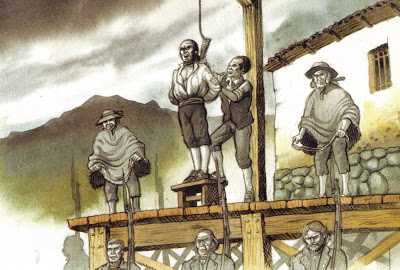Inspired by the title of Carlos Aguirre’s book, we present a series of profiles of African and Afro-descendant characters (most of whom are invisible and unknown to the general public) who, through their actions, have participated in their own freedom, the freedom to their ethnic group or the building of the free Peruvian nation that we enjoy today. On the occasion of Patriotic Month 2020, we wish to claim these characters and disseminate these names which are part of the historical, social and cultural heritage of the country.
• Francisco Congo y Manuel Lucumí | Palenques and maroons
• Antonio Oblitas | The rebellion of Túpac Amaru
• Female resistance strategies
FRANCISCO CONGO & MANUEL LUCUMÍ
Palenques & maroons
Maroon, , Francisco Congo ¨Chavelilla¨ imposed himself as the supreme chief of the Huachipa palenque. He knew how to handle internal tensions for power between ethnic blocs: he remained with political power and handed over the military leadership to a member of the opposing ethnic faction: Manuel Lucumí. He apparently exercised iron justice and personally directed the operations of the maroons: assaults and attacks on the haciendas. In 1713, despite knowing of the upcoming repression, they did not flee and led the resistance to the forces of the royal troops. The palenqueros, almost all of them bozales, used methods instilled on the African coasts to defend themselves fiercely. After 6 days, they were nevertheless arrested and brought to trial.
Did you know?
– Their surnames are actually a reference to their ethnic and geographical origin: Congo for the country of the same name and Lucumí for the delta of the Niger River in present-day Nigeria;
– On April 17, 1713, both were sentenced «to the death by strangulation with the quality of being dragged to the tail of a horse» after a trial by the Royal Court;
– The Palenque of Guachipa (Huachipa) began to function in 1710-1711 and had three enclaves and a complex political, economic, social, religious and military organization;
– The name of the hill Cerro Negro (Huarochirí, SJL) was left to remember the palenque.
What does it mean?
Palenque: remote and inaccessible place where runaway black slaves took refuge / wooden fence or stockade made to defend a post (RAE).
Maroon (cimarrón): said of a slave who took refuge in the mountains seeking for freedom (RAE).
Bozal: (lit. muzzle): said of a black slave who had just been kidnapped from his country (RAE).
Sources: P. Tardieu ¨ El palenque de Guachipa (1713) Aspectos del cimarronaje en la periferia limeña ¨, RIRA, vol. 3, n° 2 (octubre 2018) / M. Arrelucea & J. Cosamalón ¨La presencia afrodescendiente en el Perú¨, MINCUL, 2015 / C. Aguirre ¨Breve historia de la esclavitud en el Perú¨, Fondo Editorial del Congreso, 2005.

ANTONIO OBLITAS
The rebellion of Túpac Amaru
In 1780, the southern Andean Viceroyalty of Peru and the highlands were convulsed by an unprecedented emancipatory rebellion against the Spanish colonial authorities, known as ¨the rebellion of Túpac Amaru¨, nickname of the cacique José Gabriel Condorcanqui. Túpac Amaru not only led Indians and mestizos to the uprising: he made efforts to attract the black population. And this is how in the proceedings against the rebels, Antonio Oblitas is mentioned, accused of having hanged the highest Spanish authority in the area, the corregidor Don Antonio Arriaga, of whom he was a slave, and of complicity in the uprising attempted by José Gabriel Túpac Amaru. At his trial, he admitted to fighting in Sangarara. He was hanged and quartered.
Did you know that …?
– José Gabriel Túpac Amaru offered to decree the freedom of all slaves belonging to Spaniards on November 16, 1780; and on December 6, 1781, Diego Túpac Amaru offered to decree the abolition of slavery.
– José Manuel Yépes, Pedro Pablo Tagle and Miguel Landa, also enslaved, were in turn accused of complicity in the rebellion and carrying a knife. They claimed to be in charge of the kitchen. They were acquitted.
– Micaela Bastidas, José Gabriel’s wife and great protagonist of the rebellion, is identified as ¨zamba¨ because it is believed that her father Miguel Bastidas was not Spanish but black.
What does it mean?
Cacique: Ruler or head of a community or town of Indians (RAE).
Corregidor: Magistrate who in his territory exercised the royal jurisdiction with mere and mixed empire, and knew of contentious and governmental causes, and of the punishment of crimes (RAE).
Sources: S. O´Phelan Godoy ¨La rebelión de Túpac Amaru, organización interna, dirigencia y alianzas¨, Histórica, Vol. III, 1979 / J.A. del Busto ¨Breve historia de los negros del Perú¨, Fondo Editorial del Congreso, 2001/ C. Aguirre ¨Breve historia de la esclavitud en el Perú¨, Fondo Editorial del Congreso, 2005 / M. Arrelucea & J. Cosamalón ¨La presencia afrodescendiente en el Perú¨, MINCUL, 2015.

FEMALE RESISTANCE STRATEGIES
On the International Day of Afro-descendant Women, we want to highlight how invisible Afro-Peruvian women are in the construction of the national historical memory. It is the result of the writing for centuries of a subject that tends to privilege founding belligerent acts, interpreted as male acts, from a highly elitist, patriarchal and classist power. Even when the gaze turns to the acts of the indigenous and popular sectors, women are still largely absent. A deep rewriting from an intersectional perspective, that is, taking into account, in addition to gender, ethnic, cultural and social origin, is necessary to rescue the contributions of Afro-Peruvian women to the construction of the Nation.
Did you know that?
– The existence of women palenqueras has been verified with the capture of Margarita Mina, Catalina and Isabel Conga by the Santa Hermandad among the six members of the Carabayllo palenque in 1761. (1)
– The legal gaps opened by the protective decrees were strategically used by enslaved women before the courts. This is how Juana Mónica Murga demands for her own sale a fair appraisal to the court and manages to lower her price from 300 to 100 pesos with which she placed herself one step away from freedom. In her argumentation, she relates the hostile and inhuman dominion of her master, and mentions: ¨This is not even seen in Africa, and you see that we are not in the time of tyrants to shut the mouth of Christians¨ and refers to «the freedom that every man has not to be a servant, and the slave to seek a master out of the power of the one who tyrannizes him.»(2)
– During the War with Chile, Gregoria Láinez, Afro-descendant servant of Doña Antonia Moreno de Cáceres ¨carried the rifles and ammunition that [her master] could acquire and passed by the Chilean paladins, each time carrying two rifles tightly tied to the waist, concealed under her long dresses and holding a basket of ammunition by the arm, hidden among the vegetables¨.(3)
(1) Sources: Maribel Arrelucea, ¨Género, estamentalidad y etnicidad en las estrategias cotidianas de las esclavas de Lima, 1760-1800¨, TESIS para optar el grado de Magister en Historia, mención en Historia Social, UNMSM.
(2) Sources: Carlos Aguirre ¨Agentes de su propia libertad. Los esclavos de Lima y la desintegración de la esclavitud 1821-1854¨, Fondo Editorial, PUCP.
(3) Sources: Maritza Villavicencio, ¨Acciones de las mujeres peruanas durante la Guerra con Chile¨


